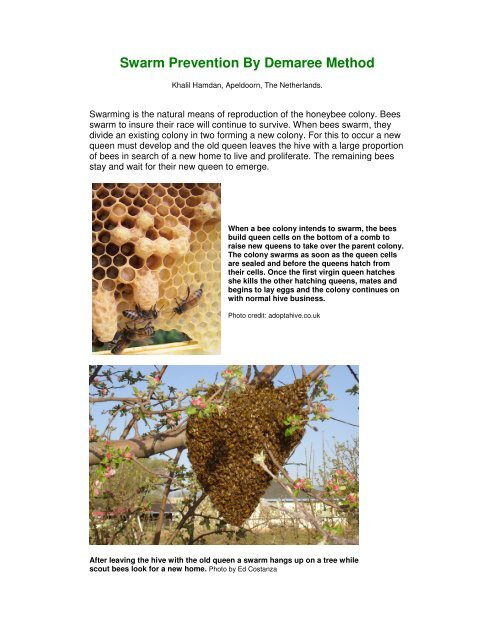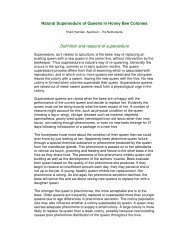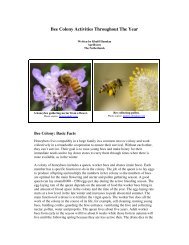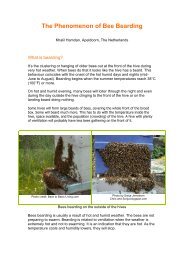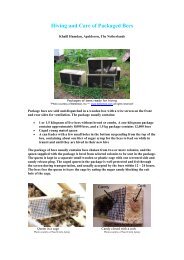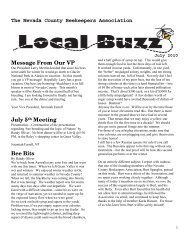Swarm Prevention By Demaree Method - Country Rubes
Swarm Prevention By Demaree Method - Country Rubes
Swarm Prevention By Demaree Method - Country Rubes
You also want an ePaper? Increase the reach of your titles
YUMPU automatically turns print PDFs into web optimized ePapers that Google loves.
<strong>Swarm</strong> <strong>Prevention</strong> <strong>By</strong> <strong>Demaree</strong> <strong>Method</strong><br />
Khalil Hamdan, Apeldoorn, The Netherlands.<br />
<strong>Swarm</strong>ing is the natural means of reproduction of the honeybee colony. Bees<br />
swarm to insure their race will continue to survive. When bees swarm, they<br />
divide an existing colony in two forming a new colony. For this to occur a new<br />
queen must develop and the old queen leaves the hive with a large proportion<br />
of bees in search of a new home to live and proliferate. The remaining bees<br />
stay and wait for their new queen to emerge.<br />
When a bee colony intends to swarm, the bees<br />
build queen cells on the bottom of a comb to<br />
raise new queens to take over the parent colony.<br />
The colony swarms as soon as the queen cells<br />
are sealed and before the queens hatch from<br />
their cells. Once the first virgin queen hatches<br />
she kills the other hatching queens, mates and<br />
begins to lay eggs and the colony continues on<br />
with normal hive business.<br />
Photo credit: adoptahive.co.uk<br />
After leaving the hive with the old queen a swarm hangs up on a tree while<br />
scout bees look for a new home. Photo by Ed Costanza
<strong>Swarm</strong>ing normally occurs in strong populous colonies, and mostly occurs in<br />
spring and early summer when weather conditions are favourable and flowers<br />
in bloom. A colony may issue several swarms leaving the hive nearly empty.<br />
<strong>Swarm</strong>ing is a problem in beekeeping. It weakens the colony and greatly<br />
reduces its honey production as the swarming occurs prior or during the main<br />
nectar flow season. Colonies that swarm do not provide a good working<br />
population for pollination of a crop.<br />
Although swarming is associated with reproduction, it can be triggered by<br />
other factors, most commonly by the following:<br />
. Overcrowding or congestion within the brood nest<br />
. The presence of an ageing queen<br />
. Insufficient space for the queen to continue laying eggs and for the worker<br />
bees to store the nectar and pollen they are bringing in to the hive<br />
. Some races of honeybees (Carniolan) are more prone to swarming than<br />
others (Italian).<br />
<strong>Swarm</strong>ing should be avoided because it severely reduces colony strength.<br />
The beekeeper should inspect his hives during the swarming season every<br />
ten to fourteen days and take measures to prevent his bees from swarming.<br />
A neglectful beekeeper may have hives that swarm often. There are several<br />
methods of preventing swarming i.e. dividing the colonies or keeping young<br />
queen or preventing overcrowding.<br />
One of the best ways to prevent a bee colony from swarming is by the way of<br />
the <strong>Demaree</strong> method. The method was devised by George <strong>Demaree</strong> and was<br />
first explained in an article in the American Bee Journal in 1884. In 1892 he<br />
again explained an improvement in his method. The objective is to separate<br />
the unsealed brood and eggs from the queen. Brood goes above an excluder,<br />
while the queen is below. This measure reduces overcrowding in the hive and<br />
therefore the bees desire to swarm; and makes it possible to retain the total<br />
colony population; and to keep honey production at a maximum. The<br />
technique has the advantage of allowing a new queen to be raised as well.<br />
It is important that <strong>Demaree</strong>’s method be applied at the correct time. The<br />
times will vary depending on the season and rate of building up and nectar<br />
source in the area (March in warmer climate, May in cooler climate).<br />
<strong>Demaree</strong> method, is carried out as follows:<br />
Step 1<br />
Remove the hive from its floorboard and put a new box with 8 drawn frames<br />
on its place.<br />
Step 2<br />
Go through the original brood box and locate the queen. Place her with two<br />
frames of sealed brood in the centre of the new box.
Step 3<br />
Place a queen excluder on this box and put a super or several supers above<br />
the excluder.<br />
Step 4<br />
Put the original brood box with remaining unsealed brood on top. Fill up the<br />
gap with 2 frames of drawn comb, one on each side. The foraging bees will<br />
return to the bottom box where the queen is and the nurse bees will stay with<br />
the brood, as if they had swarmed.<br />
Fit inner cover and roof on the stack.<br />
Step 5<br />
After 7 to10 days, inspect the hive and destroy any queen cells that may have<br />
developed in the top brood box. After then none can be started above since<br />
larvae less than three days will not be available. As the brood hatches, the<br />
combs will be filled with honey.<br />
Step 6<br />
The procedure of separating most brood from the queen is repeated after<br />
9 to10 days with queen cells destroyed in the top box. Once demareeing is<br />
completed the swarming drive is extinguished.<br />
In this rearrangement, the hive is stacked up like this:<br />
Brood box with young brood<br />
Super<br />
Queen Excluder<br />
Brood box with queen, 2 frames sealed brood & rest empty combs<br />
The colony has all of its brood and the queen, but the queen is separated<br />
from most of her brood and has a new brood nest below the excluder. A large<br />
portion of the bees is in the top where most of the brood is moved, and a<br />
small portion of the bees with a small portion of brood and queen in the<br />
bottom brood box.<br />
<strong>By</strong> doing this, the queen will have plenty of space to lay eggs and expand her<br />
brood nest; the nurse bees will be upstairs away from the brood nest in the<br />
lower box, which relieves congestion. The foraging bees will get a great deal<br />
of room to store honey in the middle hive bodies.<br />
In the top box due to the absence of the queen the bees will attempt to raise a<br />
new queen from the open brood. These can all be destroyed or used in<br />
replacing old queens and making increase (splits). Alternatively a new queen<br />
may be allowed to hatch out after selecting the best cell and inserting a<br />
screen floor under the top box as upper entrance to allow the queen to leave<br />
the hive and mate. The hive is managed as two queen colonies. What you do
after this depends on your needs. This new queen, once laying in good brood<br />
pattern can be used to re-queen the old queen or the hive is split to start a<br />
new colony, whilst still producing some honey, or after harvest.<br />
Tips and Hints<br />
1. <strong>Demaree</strong>ing or separation of the queen from the brood is intended to be<br />
used before a hive has already swarmed, and when the colony is becoming a<br />
little crowded i.e. has eight or more combs of brood and before queen cells<br />
are constructed.<br />
2. <strong>Demaree</strong> method should be applied immediately on a strong colony,<br />
showing sings of swarming (presence of several queen cells) or if the hive’s<br />
population covering all combs in a two chambers brood nest and there is no<br />
more space for egg laying.<br />
3. It is important that all queen cells in the brood boxes be destroyed that<br />
were already constructed at the time the brood is divided. When destroying<br />
the queen cells shake the bees from the combs or they will cover some of the<br />
cells, which will thus be missed. Don’t miss any. If a queen cell is missed, the<br />
hive will still swarm.<br />
4. If you have more brood than the top box can hold, you can put a few<br />
frames of sealed brood in the middle of the second super.<br />
5. When the queen fills the brood box under the queen excluder transfer the<br />
frames of unsealed brood and eggs into a top story and return 7-10 days later<br />
to destroy any subsequent queen cells.<br />
6. Remove queen excluder and recombine hive bodies when the prime<br />
swarming season is over.<br />
7. Use the <strong>Demaree</strong> method once during a season.<br />
8. Keeping a race of bees with a low tendency to swarm, and selection of non<br />
swarmy strains are the first steps to swarm prevention.


